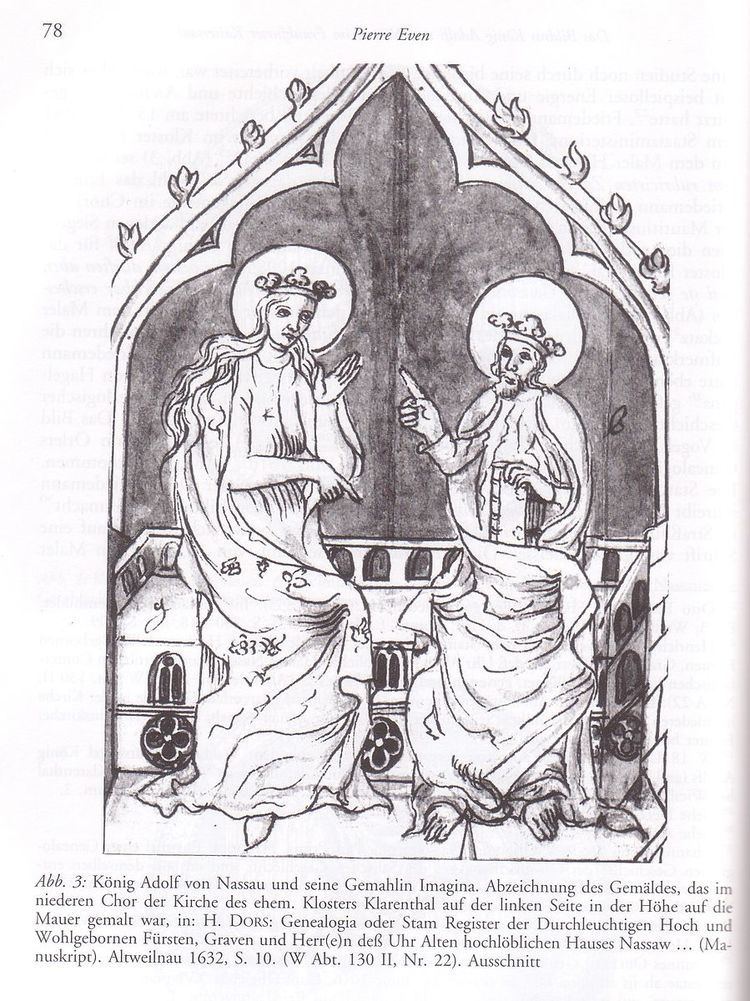Disestablished 1559 | ||
 | ||
Similar Mosburg, Villa Söhnlein‑Pabst, Locarno–Madonna del Sasso funicular, St Elizabeth's Church, Orientalischer Garten | ||
Klarenthal Abbey (Kloster Klarenthal in German) is a former convent of the Order of Poor Ladies in the borough of Klarenthal in Wiesbaden, Germany. Klarenthal was the only abbey in present-day Wiesbaden.
Contents
History as an active monastery
Klarenthal Abbey was established in 1298 by Count Adolf of Nassau (born before 1250; died July 2, 1298), who was elected King of Germany on May 5, 1292. The monastery was to serve as a tomb for the House of Nassau, and Adolf’s wife Queen Imagina of Isenburg-Limburg and many of his descendants were buried here. This continued until 1370, when, after the division of the Countship of Nassau, the preferred burial places became the central churches of the cities of residence of that particular branch of the House of Nassau. In 1429, Count Philipp I of Nassau-Weilburg-Saarbrücken was buried at Klarenthal, the last reigning member of the House of Nassau to be buried there.
The monastery belonged to the woman's Order of Poor Ladies, also known as the Poor Clares, which was founded on St. Clare of Assisi, from which is derived the name Klarenthal. Many noble women of the surrounding area joined the monastery, in particular from the Rheingau and Rheinhessen.
During the siege of Wiesbaden by Louis IV, Holy Roman Emperor in 1318, Klarenthal Abbey was looted and destroyed. It was rebuilt, however, in the following years. One hundred years later, under the abbesses Paze of Lindau (1412? - 1422) and Countess Agnes of Hanau (1446? - 1450), the monastery reached its heyday. Economically consolidated, it could also expand and decorate the ensemble of its monastic buildings. The cloister was redesigned and the church partly painted.
The Mainz Diocese Feud (1461–1462) then presented a serious setback. Although the monastery itself was not affected in the conflict, many of the properties from which the monastery's income was generated were destroyed. The monastery eventually recovered economically.
In the late 15th century and early 16th century, however, Klarenthal Abbey found it increasingly difficult to attract young women. The local gentry, from which most of the nuns once came, found itself falling behind the middle class economically more and more and no longer wanted to pay the high entrance fees for admission to the monastery. Also the reputation of monasteries suffered during the late Middle Ages, so that entry into a monastery has lower social prestige. Even the medieval idea faded that a member of a family in a monastery performed a valuable service by praying for the deceased of her family. Finally, the Protestant Reformation, which turned its back on the monastic life, sounded its death knell in the areas where it prevailed, legitimizing the seizure of the monasteries by the local lord.
From 1553, Count Philip III of Nassau-Weilburg began to take steps to dissolve the monastery. Initially, he transferred the documents and records stored there into his own possession. In addition, he prevented, by no longer issuing the necessary permits, the monastery from receiving novices or choosing a new abbess. He adopted a policy of allowing its membership to decline through attrition. Eventually, in 1559, the remaining five nuns accepted the Count’s proposal to leave the monastery in exchange for appropriate compensation. This, however, did not legally abolish the monastery since, according to the Augsburg Interim, the Count needed the Pope's consent. Nevertheless, the monastery was secularized in 1559.
Later use
Initially, the assets of Klarenthal Abbey were used to assist the poor, run by priests and teachers paid by the Countship. In 1607 the buildings were transformed into a state hospital by Count Louis II of Nassau-Weilburg. In 1632 or 1650, the epitaphs of the Counts of Nassau and their relatives interred at Klarenthal were dismantled and set up in the Mauritius Church in Wiesbaden, where they would later be destroyed in the Great Fire of 1850.
In the Thirty Years War, the buildings of Klarenthal Abbey were heavily damaged. The church was without a roof, declined to ruin, and was eventually demolished in 1756. During a time of Catholic rule during the war, the Kloster was once again used as monastery, this time of the Jesuit order. But in 1650, it was again yielded.
In 1706 it became a factory for glass. This operation existed until 1723, when a fire severely damaged the facility. From 1724, it then became a paper mill. This lasted until 1840 when another fire damaged the building and this use ended. In 1730, the small settlement, which had formed around the factory, erected a chapel, which was overseen by a pastor from Wiesbaden.
Remains
Of the original monastery buildings, little remains visible after to the repeated destruction. The present buildings partially use the foundations of the monastery buildings and in some places the walls preserve medieval stonework, including some of the arcades of the cloister. Also, spolia can be seen in various places. Anything else remaining of the original monastery is invisible to all but archaeologists. On the fields formerly belonging to Klarenthal Abbey, the housing development of Klarenthal was built in 1966, taking its name from the former monastery.
